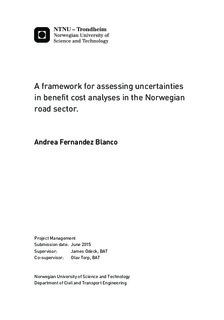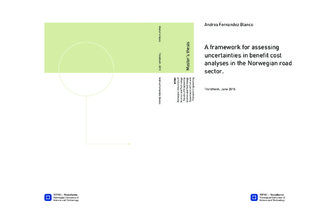| dc.description.abstract | Nowadays, every time there is a need of undertaking a project, different alternatives are considered. The differences between those alternatives can be related to technical or economical aspects, so in order to identify the best alternative a deep evaluation of both technical and economical aspects must be carried out.
According to this it is important to highlight that there exist different ways of evaluating projects depending on the impacts that are taken into account. For this reason, a big effort is needed to distinguish between impacts that can be considered when developing a benefit cost analysis and those impacts that due to the fact that cannot measurable in monetary terms must be considered as a part of another type of evaluation.
On the other hand, if the evaluation of the different alternatives focuses on the monetised terms, special factors must be considered when developing a benefit costs analysis. Some of those considerations are related to the fact that infrastructure projects have a long lifetime, which implies the need of using a long term perspective when analysing the project further in the future. In this moment is when uncertainty in relation to some of the estimates that are used when calculating cost or benefits during the whole life cycle cost of the project comes into play.
Cost estimations will highly influence the decision-making process regarding the selection of the preferred alternative to be implemented when considering several road projects. For this reason many governments have published their own standards or guidelines with the aim of including all the existing tools and knowledge that are available in order to create good cost estimations. However, it is the consideration of the uncertainties which makes the task of making good estimates more and more challenging. Thus, during the pre-investment phases, where there is a higher level of a uncertainty and a relevant lack of definition, the process of obtaining accurate estimations become very complex.
On the other hand, later on when cost estimations are used in the benefit cost analysis, there exist again a need to include those uncertainty factors as aspects that must be taken into account when choosing between different alternatives, but this is something that is not commonly applied in Norway.
For this reason, this work propose, by taking into account the stochastic nature of the project costs, a possible solution to this matter, which constitutes an academic effort to contribute to the improvement of the basis for the decision making process. It is important to notice that in some cases a reduction of the uncertainty in a project can be preferable instead of a project with a high profitability. For this reason what the proposed solution suggests is not only a framework to simplify the methodology used when calculating confidence intervals in relation to the BC-ratio, but also a methodology to rank projects where uncertainty factors can be considered with the aim of aiding decision makers to identify those projects with lower levels of uncertainty. | |

